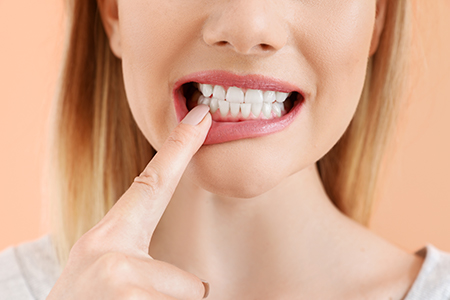
Our Office
Visit Us Online

Gum disease is far more than a cosmetic concern — it’s the leading reason adults lose natural teeth, and it quietly affects millions of Americans. Research shows periodontal conditions become increasingly common after age 30, and because early stages are often subtle, many people don’t realize they have a problem until damage has occurred. At Towne Dental & Orthodontics, we focus on preventing progression and restoring gum and bone health so patients can keep comfortable, functional smiles for years to come.
Periodontal disease starts when bacteria in dental plaque cling to teeth and gums, triggering an inflammatory response. Over time, that inflammation can damage the tissues that hold teeth in place — the gums, periodontal ligaments, and jawbone. What starts as mild irritation may become a chronic condition that undermines dental stability if left unaddressed.
Because the early stages often cause few obvious symptoms, routine dental exams are essential. Professional evaluation allows a clinician to measure pocket depths around teeth, look for attachment loss, and identify early signs that home care alone isn’t sufficient. Catching problems early preserves options and usually leads to simpler, more predictable treatment.
Being informed about the common warning signs helps you notice changes sooner. If you observe any of the indicators below, a prompt evaluation can determine whether treatment is needed to stop the disease process and protect your long-term oral health.
Common signs you should have checked by a dentist include:
Red, puffy, or tender gums
Bleeding during brushing or flossing
Gums that are pulling away from teeth or exposing root surfaces
Increased sensitivity to hot or cold
Persistent bad breath or an unpleasant taste in the mouth
Teeth that feel loose or shifting in position
New gaps between teeth or a change in how your bite fits together
Partial dentures that no longer fit well
Pus or discharge around the gumline
Discomfort when biting or chewing

Oral health is closely linked to overall health. Inflammatory processes that begin in the mouth can influence conditions elsewhere in the body, and researchers continue to explore connections between periodontal disease and systemic illnesses such as cardiovascular disease, diabetes, and respiratory concerns. Keeping gums healthy reduces local damage and supports broader wellness.
Good gum care also preserves the foundation for functional teeth. Healthy periodontal tissues provide the necessary support for chewing, speech, and the long-term success of restorations like crowns, bridges, and implants. When those tissues are compromised, restorative outcomes become harder to achieve and maintain.
At our practice, prevention and early intervention are central to care. We emphasize practical hygiene strategies, targeted professional cleanings, and ongoing monitoring to stop disease progression before it requires more invasive measures. Patients who stay engaged with these routines generally enjoy better outcomes and fewer complex procedures.
Gingivitis is the reversible form of gum disease. During this stage the infection is limited to the soft tissues of the gums and has not yet caused permanent attachment loss. Common signs include gum redness, swelling, and bleeding when you brush or floss. Because these symptoms are sometimes mild, many people ignore them until they worsen.
The good news is that with consistent professional care and improved oral hygiene at home, gingivitis can usually be resolved. A focused cleaning to remove plaque and calculus, combined with guidance on brushing and flossing techniques, often restores tissue health. In many cases, this prevents progression to more destructive stages of disease.
Follow-up care is critical after treating gingivitis. Regular maintenance visits allow your dental team to confirm healing, reinforce effective home care, and intervene quickly if inflammation returns. Early attention saves healthy tissue and simplifies long-term maintenance.

Periodontitis develops when gingival inflammation advances and the attachments that anchor teeth begin to break down. This stage involves pocket formation, gum recession, and loss of the supporting bone. As the disease deepens, pockets become more difficult to clean effectively with routine home care, and the risk of tooth mobility increases.
Treatment at this stage focuses on halting the destructive process and rebuilding as much support as possible. That often requires a combination of thorough cleaning below the gumline, localized antimicrobial therapies, and in some cases surgical or regenerative approaches to restore lost tissue and bone.
Prognosis depends on disease severity, response to therapy, and the patient’s commitment to ongoing care. With coordinated treatment and regular maintenance, many patients stabilize their condition and preserve natural dentition that would otherwise be at risk.
Contemporary periodontal care blends conservative therapy, targeted medications, and advanced surgical techniques when needed. The goal is to remove the biological cause — bacterial biofilm and tartar — and then create an environment where tissues can heal and remain healthy. Treatment is individualized based on clinical findings, medical history, and personal goals for oral function and appearance.
Advances such as localized antimicrobials, laser-assisted procedures, and regenerative grafting have expanded the tools available to clinicians. These options can reduce pocket depths, encourage new tissue attachment, and restore lost bone volume in appropriate cases. Even when surgery is necessary, modern protocols aim to be as conservative as possible while delivering reliable results.
Patient participation is a major factor in success. Improved home care, smoking cessation, and control of systemic conditions like diabetes all influence healing and long-term stability. Your dental team will work with you to build an achievable plan that supports both immediate repair and lasting maintenance.
After a comprehensive assessment, periodontal therapy usually falls into two broad categories: non-surgical care focused on infection control and surgical procedures intended to access and restore damaged tissues. Each approach has specific aims and is selected to match the clinical needs of the individual patient.
We’ll outline the typical options below and explain how they fit into an overall treatment plan. Your clinician will discuss which methods are most appropriate for your situation and what each step will involve so you can make informed decisions about care.

Early and moderate cases frequently respond well to non-surgical therapy. Scaling and root planing (deep cleanings) remove plaque and calculus below the gumline and smooth root surfaces to discourage re-accumulation of bacteria. These procedures are often combined with prescription rinses or localized antimicrobials to enhance bacterial control.
Non-surgical care is designed to reduce inflammation, shrink pockets, and restore tissue health without cutting. Many patients experience significant improvement and can maintain gum health with scheduled maintenance visits and effective daily hygiene.
If initial measures do not produce stable improvement, your clinician will recommend further steps tailored to the areas that remain affected.
When pockets are too deep for thorough cleaning or when significant bone loss has occurred, surgical intervention is often necessary. Flap procedures (pocket reduction) allow the clinician to access root surfaces and bone directly, remove diseased tissue, and recontour underlying structures to facilitate cleaning and healing.
Regenerative techniques, including bone grafts and guided tissue regeneration, aim to encourage the body to rebuild lost bone and connective tissue in appropriate cases. These procedures can improve support for teeth and enhance the long-term success of restorative work, including implants when indicated.
Adjunctive technologies such as lasers can be useful for specific applications, including reducing pocket bacteria and reshaping soft tissue. Your clinician will explain the expected benefits and discuss recovery and maintenance requirements after any surgical procedure.
If you have questions about gum health, want a thorough evaluation, or are seeking treatment to address active periodontal disease, our team is here to help. Contact us to learn more about how we can preserve and restore your oral foundation.
Most people don’t realize that periodontal disease is the leading cause of tooth loss among adults. According to statistics from the Centers for Disease Control and Prevention, one out of every two adults over the age of 30 in the United States has periodontal disease.
You may be surprised to learn that the human mouth is home to a wide variety of microbes. The fact is that over 700 different strains of bacteria have been detected in the oral cavity. Although some of these bacteria are beneficial, others are harmful to oral health. Without proper oral hygiene and routine dental care, these harmful bacteria can cause tooth decay and gum disease, compromising both your oral health and overall wellbeing.
In addition to inadequate oral hygiene and infrequent professional care, other factors, including smoking, genetic tendencies, and unchecked diabetes, can contribute to the escalation of periodontal disease.
Your gums and teeth have an interdependent relationship, which means healthy teeth depend on the support of healthy gums. Also, taking care of your smile does more than keep your teeth and gums in optimal condition; good oral health also supports systemic health. In addition to being the leading cause of tooth loss in adults, researchers are finding more and more links between periodontal disease and a number of medical problems, including heart disease, stroke, diabetes, respiratory problems, and adverse pregnancy outcomes such as pre-term and low birth-weight babies.
If you notice that your gums are bleeding with the slightest pressure while brushing or flossing, it’s a sign of gingivitis. Although gingivitis is the earliest stage of gum disease, it can easily be reversed with deeper cleanings as well as an improved regimen of oral hygiene at home.
In the absence of professional treatment and better home care, gingivitis progresses to the next stage, which is known as periodontitis. In this stage, the connective tissue and bone that hold the teeth in place begin to break down with an increase in pocketing between the teeth and bone, gum recession, and bone loss. Without proper treatment by your dentist, periodontitis will progress from a mild to moderate loss of supporting tissue to the destruction of the bone around the teeth.
Although gingivitis can often be reversed with improved oral hygiene and professional cleanings, as periodontal disease advances, more extensive procedures are required to halt its progression. Based on a complete assessment of your periodontal health and a review of possible contributing factors, our office will recommend the best options in care. Treatment for periodontitis may include a series of deeper cleanings known as root planing and scaling, surgical procedures to reduce pocket depth, bone or tissue grafts, laser procedures, or antimicrobial medications.
The cost of care depends on the type of procedures required to restore your periodontal health. If you have dental insurance, plans often cover treatment to prevent gum disease as well as many procedures to treat the various stages of gum disease. Our goal is to help patients restore and maintain good oral health. We do all we can to help you begin care without additional stress or delay. Our business office works with you to maximize your benefits and provide easier, more convenient payment options.
By seeing our office regularly for care and doing your best to eat a healthy diet and practice good oral hygiene, you can keep your smile in tip-top shape as well as protect your overall wellbeing.
At the office of Towne Dental & Orthodontics, we provide a comprehensive range of services to address all your oral healthcare needs. You can rest assured that your smile is in the best of hands at our office. Our skilled and experienced team maintains a position at the forefront of advances in care and remains dedicated to providing the highest quality of skilled and compassionate treatment.
Periodontal disease is an infection-driven inflammation that affects the gums and the supporting structures around teeth, including the periodontal ligaments and jawbone. It begins when bacterial plaque accumulates at the gumline and triggers a persistent immune response that damages soft tissues. Left untreated, this process can advance from reversible gingivitis to destructive periodontitis that undermines tooth support.
In early stages the signs may be subtle, which is why routine exams are important to detect pocket formation and attachment loss before irreversible damage occurs. As pockets deepen and bone is lost, cleaning at home becomes less effective and more involved professional care is required. Timely intervention preserves options and improves the likelihood of stabilizing the condition.
Several warning signs indicate you should schedule an evaluation, including red, swollen, or tender gums and bleeding during brushing or flossing. You may also notice persistent bad breath, gums that are pulling away from teeth, increased tooth sensitivity, or changes in how your bite fits together. Any loosening of teeth, new gaps, or discharge at the gumline also warrants prompt attention.
Because early gum disease can be painless, routine dental exams help catch problems before symptoms worsen. If you observe any of these signs, a clinician can perform focused measurements and tests to determine whether treatment is needed. Early detection usually leads to simpler, more predictable care and better long-term outcomes.
Diagnosis begins with a thorough clinical evaluation that includes pocket depth measurements, assessment of attachment levels, and inspection for gum recession and inflammation. Dentists often use periodontal charting to record these findings and take dental radiographs to evaluate bone levels around teeth. Mobility tests and visual inspection for pus or tissue breakdown help identify active disease areas that need attention.
Medical history and risk factors such as smoking, diabetes, and certain medications are also considered because they influence treatment planning and prognosis. A complete picture allows the clinician to stage the disease, recommend appropriate therapies, and set a maintenance schedule tailored to the individual. Ongoing re-evaluation is important to monitor response to therapy and adjust care as needed.
Non-surgical therapy focuses on removing the biological cause of disease by eliminating plaque and calculus from tooth roots below the gumline through scaling and root planing. These deep cleanings smooth root surfaces and reduce bacterial reservoirs, often combined with prescription antiseptic rinses or localized antimicrobials to enhance bacterial control. When applied early and followed by improved home care, non-surgical measures can shrink pockets and resolve inflammation for many patients.
Adjunctive treatments such as targeted antibiotic gels or sustained-release antimicrobials may be used in localized sites that do not respond fully to mechanical cleaning. Maintenance appointments are critical after initial therapy to confirm healing and prevent recurrence. If non-surgical measures fail to produce stable improvement, the clinician will discuss additional options tailored to the affected areas.
Surgical therapy is recommended when pockets remain too deep for effective cleaning, when there is significant bone loss, or when regenerative procedures are needed to restore support. Common surgical approaches include flap surgery to access and thoroughly clean root surfaces, pocket reduction, and recontouring of bone to create a healthier environment for the gums. These procedures allow direct removal of diseased tissue and facilitate better long-term maintenance of the area.
Regenerative techniques, such as bone grafting and guided tissue regeneration, aim to encourage the body to rebuild lost bone and connective tissue in suitable cases. Recovery typically involves a short period of controlled oral hygiene and follow-up visits to monitor healing. Your clinician will explain the expected benefits, risks, and post-operative care so you can make an informed decision about surgical options.
Contemporary tools such as dental lasers and localized antimicrobial therapies expand the clinician's ability to reduce bacterial load and manage inflamed tissue with precision. Lasers can be used to remove diseased pocket lining, reduce bacteria, and stimulate healing in some clinical situations while often being less invasive than traditional surgery. Localized antimicrobials deliver targeted medication directly into periodontal pockets to suppress pathogens without relying on systemic antibiotics.
These technologies are used selectively based on clinical indications and evidence of benefit for the individual patient. When combined with thorough mechanical cleaning and a strong maintenance plan, adjunctive tools can improve pocket reduction and tissue response. Your clinician will review whether these options are appropriate for your specific needs and explain how they fit into a comprehensive treatment strategy.
Research shows that chronic oral inflammation has links to systemic health concerns, and while causal relationships remain an active area of study, associations have been identified with conditions such as cardiovascular disease, diabetes, and certain respiratory issues. Periodontal inflammation contributes to the body's overall inflammatory burden, and poor oral health can complicate the management of some medical conditions. For patients with systemic illnesses, controlling periodontal disease is an important component of comprehensive care.
Because of these interactions, clinicians often coordinate with a patient's medical providers when systemic conditions or medications influence periodontal treatment or healing. Optimizing oral health can reduce local tissue damage and support broader wellness goals. Open communication about medical history and overall health helps ensure safe, effective periodontal care.
Daily home care is the foundation of periodontal disease prevention and management; effective brushing, flossing, and interdental cleaning remove the biofilm that fuels inflammation. Patients with a history of periodontitis often need more meticulous oral hygiene and may be advised to use specific tools or antiseptic rinses to control bacteria between professional visits. Consistent daily care directly influences healing and the durability of treatment results.
Professional maintenance visits are equally important and are scheduled at intervals based on disease severity and risk factors, commonly every three to four months for those who have treated periodontitis. During maintenance, clinicians remove recurrent deposits, reassess pocket depths, and reinforce home care techniques to prevent relapse. A collaborative, disciplined maintenance program is a major predictor of long-term stability.
In many cases, regenerative procedures can encourage partial rebuilding of lost bone and connective tissue using techniques such as bone grafts, membranes for guided tissue regeneration, and biologic growth factors. These therapies aim to restore the supporting structures around teeth when clinical conditions are favorable and when patients commit to the necessary post-operative care. Success depends on disease severity, the specific defect being treated, and patient factors like smoking status and systemic health.
Not all tissue loss can be completely restored, and realistic expectations are important when planning regenerative treatment. Early intervention improves the likelihood of meaningful regeneration, while ongoing maintenance is essential to protect any gains achieved. Your clinician will evaluate the nature of the defect and recommend the most appropriate regenerative or stabilizing approach.
At Towne Dental & Orthodontics the care team begins with a comprehensive assessment that includes periodontal charting, radiographs, a review of medical history, and a discussion of individual goals and risk factors. Based on those findings, we create a tailored plan that can range from conservative scaling and root planing to targeted adjunctive therapies or surgical and regenerative procedures when indicated. Treatment choices are explained in plain terms so patients understand the rationale and what to expect at each step.
Dr. Paula Herber and the clinical team emphasize practical home care, smoking cessation support when relevant, and coordinated communication with medical providers for patients with systemic conditions. Follow-up and maintenance schedules are customized to each patient's response and long-term risk profile, and our office in Waller, TX provides ongoing monitoring to help preserve oral foundation and function. This individualized approach helps patients achieve the best possible outcomes while maintaining comfort and convenience.